A Legacy of
Microscopy for Kids
by Guido Santacana, Puerto Rico
(Note: images with blue borders are
clickable to show detail).
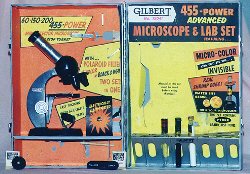 Just recently, while
"browsing" through a used-things shop in cyber city, I
found something that brought many memories about my beginnings in
microscopy. It was an old A.C. Gilbert microscope set from the
very early 1960's. In fact it was exactly the same first set that
I ever had. As you can imagine, the set with the beautiful black
microscope is now in my hands (see Fig 1 right).
Just recently, while
"browsing" through a used-things shop in cyber city, I
found something that brought many memories about my beginnings in
microscopy. It was an old A.C. Gilbert microscope set from the
very early 1960's. In fact it was exactly the same first set that
I ever had. As you can imagine, the set with the beautiful black
microscope is now in my hands (see Fig 1 right).
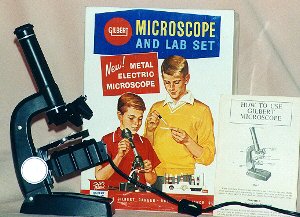 It took some cleaning and
a minor repair to have the microscope working properly but it was
worth it. I placed my first slide on the stage of the recently
refurbished 35 year old instrument and, while looking at the
intricacies of a grass stem, I realized the reason why microscopy
became so interesting for me as a kid. This microscope really
performed well and,in addition, the set included everything you
needed to do a reasonable set of 260 experiments described in a
very well written and illustrated instruction manual. After an
excellent description of the microscope and its operation, the
manual gave clear and concise instructions on how to prepare
different materials for observation. The areas covered went from
biology to criminology. I remember working for hours with the set
and using the manual as my only mentor.
It took some cleaning and
a minor repair to have the microscope working properly but it was
worth it. I placed my first slide on the stage of the recently
refurbished 35 year old instrument and, while looking at the
intricacies of a grass stem, I realized the reason why microscopy
became so interesting for me as a kid. This microscope really
performed well and,in addition, the set included everything you
needed to do a reasonable set of 260 experiments described in a
very well written and illustrated instruction manual. After an
excellent description of the microscope and its operation, the
manual gave clear and concise instructions on how to prepare
different materials for observation. The areas covered went from
biology to criminology. I remember working for hours with the set
and using the manual as my only mentor.
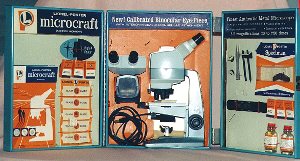 The result of finding
this microscope set has been the start of a small collection.
Some more A.C. Gilbert sets have fallen in my hands (see Figure 2
above), as well as two other sets from the same period, a
Lionel-Porter and Tasco (see Figure 3 below and Figure 4 right).
The result of finding
this microscope set has been the start of a small collection.
Some more A.C. Gilbert sets have fallen in my hands (see Figure 2
above), as well as two other sets from the same period, a
Lionel-Porter and Tasco (see Figure 3 below and Figure 4 right).
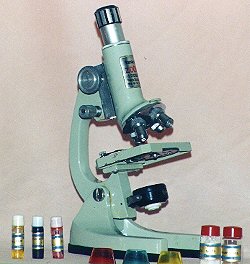 The
common factor in all of these microscopes is optics. Most of them
will not magnify over 450X to 500X which is reasonable. The
lenses are made of good quality glass and not plastic like many
of today's microscopes sold in toy stores. In other words, you
can see clear images! I remember observing most of the common
protozoa with my old Gilbert. In addition to the microscopes
these kits included almost everything you needed to carry out
most of the experiments in the manual.
The
common factor in all of these microscopes is optics. Most of them
will not magnify over 450X to 500X which is reasonable. The
lenses are made of good quality glass and not plastic like many
of today's microscopes sold in toy stores. In other words, you
can see clear images! I remember observing most of the common
protozoa with my old Gilbert. In addition to the microscopes
these kits included almost everything you needed to carry out
most of the experiments in the manual.
A sample of the contents in a Tasco set (see
Figure 5 below) included blank slides, prepared slides, Canada
balsam, various stains, diatomaceus earth, alcohol, xylol,
feathers, fish scales and even brine shrimp eggs. Other sets even
included preserved animals. Polarizing filters were always there
with a set of slides to be observed through crossed polars. You
could work for years with one of these sets due to another
important characteristic, the microscopes were rugged and could
suffer the wear and tear that a 12 year old could provide them
with.
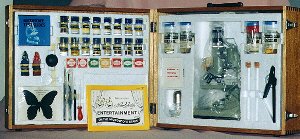
I have not been able to find a microscope sold in a toy store
that can even come close to the performance of these older
instruments. The "toy" microscope sets of the 50's and
60's left a permanent impression on those who owned them and a
legacy of interest in microscopy that has endured all these years
regardless of the pathways that our lives may have taken.
On subsequent articles I will describe some of the more
interesting sets in my growing collection.
Comments to the author Guido
Santacana welcomed.
Editor's note: Read Guido's latest article on
toy microscopes, the 'Amerscope
Reflecting Microscope'.
© Microscopy UK or their
contributors.
Please report any Web problems
or offer general comments to the Micscape Editor,
via the contact on current Micscape Index.
Micscape is the on-line monthly
magazine of the Microscopy UK web
site at Microscopy-UK
WIDTH=1
© Onview.net Ltd, Microscopy-UK, and all contributors 1995 onwards. All rights
reserved. Main site is at www.microscopy-uk.org.uk with full mirror at www.microscopy-uk.net.
 Just recently, while
"browsing" through a used-things shop in cyber city, I
found something that brought many memories about my beginnings in
microscopy. It was an old A.C. Gilbert microscope set from the
very early 1960's. In fact it was exactly the same first set that
I ever had. As you can imagine, the set with the beautiful black
microscope is now in my hands (see Fig 1 right).
Just recently, while
"browsing" through a used-things shop in cyber city, I
found something that brought many memories about my beginnings in
microscopy. It was an old A.C. Gilbert microscope set from the
very early 1960's. In fact it was exactly the same first set that
I ever had. As you can imagine, the set with the beautiful black
microscope is now in my hands (see Fig 1 right). 

 The
common factor in all of these microscopes is optics. Most of them
will not magnify over 450X to 500X which is reasonable. The
lenses are made of good quality glass and not plastic like many
of today's microscopes sold in toy stores. In other words, you
can see clear images! I remember observing most of the common
protozoa with my old Gilbert. In addition to the microscopes
these kits included almost everything you needed to carry out
most of the experiments in the manual.
The
common factor in all of these microscopes is optics. Most of them
will not magnify over 450X to 500X which is reasonable. The
lenses are made of good quality glass and not plastic like many
of today's microscopes sold in toy stores. In other words, you
can see clear images! I remember observing most of the common
protozoa with my old Gilbert. In addition to the microscopes
these kits included almost everything you needed to carry out
most of the experiments in the manual. 